















Today’s students are tomorrow’s leaders. Exactly why Blach Construction is proud to partner with California’s educators to deliver state-of-the-art facilities where learners of all ages thrive.
Whether you’re looking to modernize existing spaces or create all-new learning environments, look to Blach. Together, we will build futures – for everyone.
Trust your next education project to Blach Construction.
As a Third-Party Administrator (TPA), SchoolsFirst Plan Administration expertly manages the day-to-day responsibilities of California school employee retirement plans.
• We process your employee contributions securely with a remittance turnaround of 24 hours — fastest in the industry.
• As a local and not-for-profit organization, we’re committed to delivering personalized service to you at all times.
• We provide complimentary financial education through workshops, programs, articles and consultations.
We ensure a smooth transition by managing the entire process from start to finish.
CALL (800) 462-8328, ext. 4727
EMAIL rpa@schoolsfirstfcu.org
VISIT schoolsfirstfcu.org/tpa
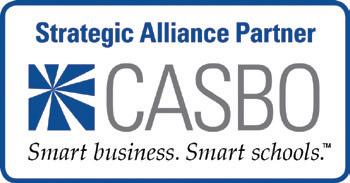



















Your annual enrollment doesn’t have to take so much time.

Customized Enrollment Communication

Employee Benefits Education
Benefits Admin System


Enrollment Support



You spend a lot of time preparing for and executing your annual benefits enrollment. American Fidelity brings representatives to your organization to handle all aspects of your enrollment. We’ll service your entire open enrollment at no additional cost*, and we’ll be there year-round for new hires and life status changes.
*Provided at no additional cost as permitted by law.
We can help! Contact me today.
nancy.damuro-olszeski@americanfidelity.com 800-365-9180
SB-33213-0421







90 Number one Summer 2025
9 CHECKING IN Navigating Pressure With Purpose
Tatia Davenport
11 BOTTOM LINE Eye of the Tiger
Aaron Heinz
13 GUEST FEATURE When You’re Overloaded –and Delegating Isn’t an Option
Franz van Loef and Jordan Stark
19 IN FOCUS MEMBER
Andrew Soliz
21 IN FOCUS ASSOCIATE MEMBER
Kim Scott
24 INTERVIEW
Neil Hoyne Google’s Chief Strategist Discusses How School Leaders Can Use Data to Their Advantage
Julie Phillips Randles
30 COVER FEATURE Setting the Table for Success 8 Tips for Collective Bargaining in Challenging Times
Jennifer Snelling
38 FEATURE Be Ready for (Almost) Anything Use a 6-Step Scenario Planning Approach to Prepare for Multiple Possible Futures
Jennifer Fink



The California Association of School Business Officials is the premier resource for professional development in all aspects of school business. Founded in 1928, CASBO serves more than 30,000 members by providing certifications and training, promoting business best practices, and creating opportunities for professional collaboration. CASBO members represent every facet of school business management and operations. The association offers public school leaders an entire career’s worth of growth opportunities.
As the recognized authority in California school business, CASBO is a member-driven association that promotes ethical values; develops exceptional leaders; advocates for, and supports the needs of, members; and sets the standard for excellence through top-quality professional development and mentorship, meaningful collaboration and communication, and unparalleled innovation.
For the past 16 years, CASBO has been dedicated to the organizational planning discipline as a method for guiding the association into a successful future. Last year, the association completed its sixth such plan, CASBO by Design 2.0, a living, breathing document that guided the association in its long-term planning process, which is grassroots in nature, invigorating in procedure and motivating in outcome. Work on our next strategic plan began in 2021.
CASBO has long been committed to organizational planning because the approach has consistently helped the association envision its future and determine the clear steps to get there. The roadmap that strategic planning provides has allowed CASBO to remain focused on its unique mission, goals and objectives and to respond effectively to a continually changing environment.
For more information on CASBO by Design, visit casbo.org > CASBO + You > About > CASBO By Design.
Stay connected casbo.org
Publisher Tatia Davenport
Features Editor
Julie Phillips Randles
Contributors
Jennifer Fink
Jennifer Snelling
Art Director Sharon Adlis
Ad Production
Tracy Brown
Advertising Sales Manager Cici Trino Association Outsource Services, Inc. P.O. Box 39 Fair Oaks, CA 95628 (916) 961-9999
the publisher. Published June 2025
CASBO OFFICERS
President
Aaron Heinz Colusa County Office of Education
President-Elect
Katie Hylton
San Bernardino County Superintendent of Schools
Vice President
Kristi Blandford
San Juan Unified School District
Immediate Past President
Eric Dill Poway Unified School District

Piper Sandler is a leader in providing financial services to California public schools. We guide school districts and community college districts across the state on the financing tools used to fund the construction and modernization of school facilities, school site acquisitions and upgrading of technology equipment. Our team assists K-14 districts on navigating the complex general obligation bond process from start to finish and can provide insights on leveraging state matching funds. We have a dedicated California banking and underwriting team to serve your district and can provide access for communities to participate in their local bond offerings.
General obligation bonds | Certificates of participation | Mello-Roos/CFD bonds
Interim project financing | Bond anticipation notes | Tax & revenue anticipation notes
Rich Calabro
MANAGING DIRECTOR +1 310 297-6013 richard.calabro@psc.com
Halina De La Rosa
ASSISTANT VICE PRESIDENT +1 310-297-6033 halina.delarosa@psc.com
Jin Kim MANAGING DIRECTOR +1 310 297-6020 jin.kim@psc.com
Celina Zhao ASSISTANT VICE PRESIDENT +1 310 297-6019 celina.zhao@psc.com
Visit us at pipersandler.com/CAeducationfinance
Ivory Li MANAGING DIRECTOR +1 415 616-1614 ivory.li@psc.com
Dennis McGuire MANAGING DIRECTOR +1 916 361-6520 dennis.mcguire@psc.com
Christen Gair MANAGING DIRECTOR +1 310 297-6018
christen.gair@psc.com
Pam Morris-Hammer OFFICE SUPERVISOR +1 310 297-6023 pamela.hammer@psc.com

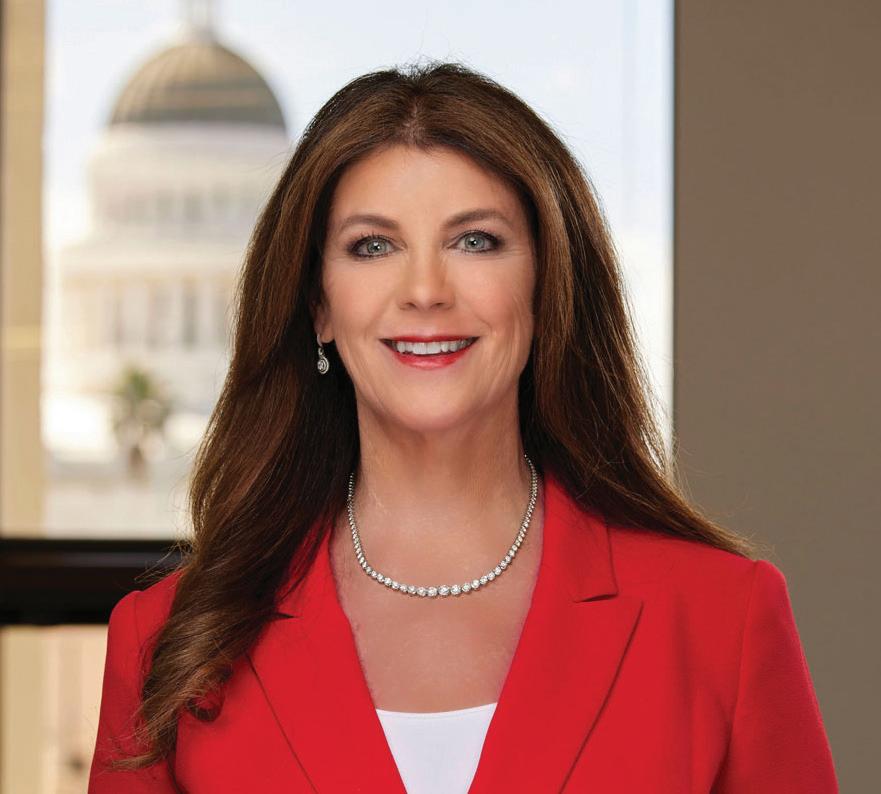

There are seasons in leadership when the weight feels undeniable – tight budgets, rising expectations and decisions that carry real, long-term impact. This is one of those seasons.
What I see emerging, though, is something powerful: A shift toward intentional leadership. More than reacting to problems, leaders at all levels are creating space to plan for what’s next – to shape possibilities, while also managing the present. They’re choosing clarity over urgency, and strategy over survival.
This issue reflects that shift. It’s about the quiet strength it takes to lead through pressure, not just absorb it. It’s about holding steady in uncertainty, making thoughtful choices and staying connected to purpose – even when delegation isn’t an option.
Progress doesn’t always roar. Sometimes, it looks like discipline, dialogue and the courage to stay focused on what matters most.
We’re walking this path together – and that’s what makes the difference. z z z
Tatia Davenport CEO


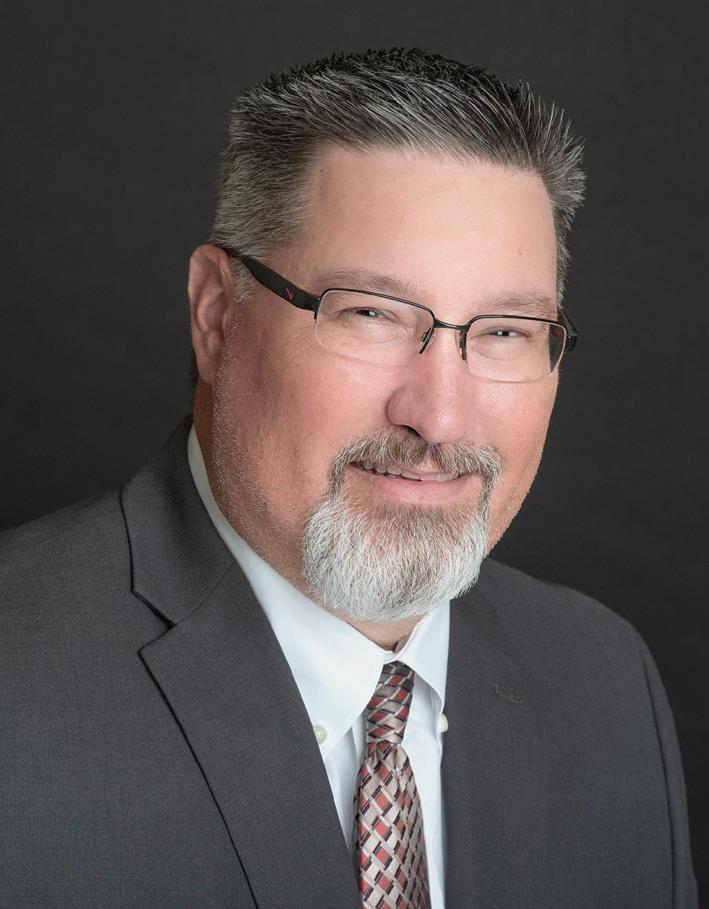
In 2022, I wrote in my candidate’s statement for CASBO vice president: “The history of CASBO is rich and bountiful, and filled with the names of distinguished leaders who sacrificed the most valuable asset I believe we can give someone else – our time. CASBO is built on making others better, à la iron sharpens iron. Its members, like you, strive not only on becoming better for themselves, but in making the lives of children, and those who support children, easier; a truly noble and selfless goal. We are all educators in this regard.”
As I assume the role of CASBO president, I find myself looking back at my career and how key figures – mentors – played such a vital role in not only my own success, but in that of the organizations I’ve been a part of.
So, why “Eye of the Tiger?” What’s that all about? First of all, it’s a great ‘80s song, but there’s so much more to it than that.
In 1982, my dad took me to see “Rocky III.” It’s a movie about loss, pulling others up, and ultimately, redemption.
In the movie, when Rocky was at his lowest, his friend, Apollo Creed, pleads with him, saying, “You had that eye of the tiger, man, the edge. … You gotta get it back!” It’s a metaphor for the mindset needed to succeed against tough challenges – determination, focus and mental strength in the face of adversity.
Early in my career, I had a small but powerful collection of mentors who echoed similar encouragements as I was making my way up. They all belonged to CASBO and were my first introduction to what would become a learning lesson of life: Make the team around you smarter and you’ve got yourself a great team.
Let’s not mince words here – school business is hard. It’s pushed a high percentage of great CBOs and directors into early retirement or out of the industry in the past few years.
But what that means for you, sitting at your desk processing A/P batches, creating journal entries or reviewing budgets for the first time, is that there’s opportunity for you here, and we want you to rise to the occasion.
Not only that, we want to pull you up – right now! Be that next leader. Be the one writing these columns. Be the one who others count on for their successes.
That’s what CASBO can do for you.
That’s the Eye of the Tiger. z z z

Aaron Heinz CASBO President


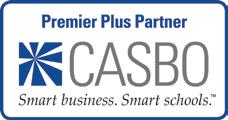

By Frans van Loef and Jordan Stark
When managers are overloaded as many are now, the usual leadership advice is to delegate more. But what if you’ve delegated everything you can and you still have too much work? If your team is drowning too, delegating more work simply means shifting the overload. This is not a sustainable option.
We have seen this situation many times working with hundreds of leaders and teams in our consulting and coaching work. Fortunately, there are three key strategies you can use to reassess and
reconfigure the work you do to free up your limited time and capacity.
1. Make sure your team really understands what “good enough” looks like.
It’s easy to think that every piece of work should be an A+. But if everything you or your team does is “excellent,” you are overdoing quality, stressing your team, wasting energy and slowing down progress.
We encourage leaders to work in a “fit-for-purpose way.” That means intentionally assessing what level of effort makes sense for a given piece of work. Do you discuss what is “good enough” for specific assignments with your team members? Or what corners should be cut?
One example of a client who managed effort and time well was a CEO one of us (Jordan) coached who understood what was important and what wasn’t. He told his board that he was going to
send weekly email updates and that these notes would be a “brain dump,” without any editing. This allowed him to keep his board informed in real time and didn’t waste his own critical leadership capacity.
In a different organization with a process-heavy culture, the leadership team was in the habit of soliciting employee feedback on a lot of organizational decisions. You might think that employees would love this high-involvement approach, and occasionally they did. Overall, however, staff regularly complained that the organization was too process heavy, and it made their jobs and lives harder, not better. We coached this CEO and team to use different decisionmaking processes depending on the importance or risk of the issue, and to streamline whenever possible.
Another executive client now asks her direct reports to share quick, firstdraft plans with her for work that is not overly complex or risky, instead of perfect multi-page documents. She also encourages her team to send bullet-point emails, when possible, instead of long narratives, with the understanding that she will follow up if she has questions. The team is also looking into how they can leverage AI to make work less labor intensive.
If you and your team are too busy, it’s essential to take time to figure out how to work differently.
Ask yourself and discuss with your team:
• Where could you do B-quality work, cut corners or streamline processes to save yourself time and energy? For example, can you shorten weekly updates? Can you send bullet points instead of narratives? Do you really need a full project plan if the situation is simple?
• What agreements could you make with your boss to simplify or reduce
deliverables and processes? For example, could you tell your boss that it would be helpful if you could send simpler or fewer communications? Will a rough draft suffice instead of a perfect document to get the information across? Can a decision-making process be streamlined?
• How can AI support you and your team in reducing time required for “good enough” work? Ask your team what apps they are starting to experiment with and encourage them to do more. For example, meeting summary apps have gotten really good. First draft writing apps are also helpful. We brainstormed with colleagues recently and came up with an impressive list of tools with which to start experimenting.
When managers and teams step back to assess if there are tasks on which they can lower the bar strategically, the answer is almost always yes, and encouraging “good enough” work energizes the team.
2. Identify and eliminate hidden low-value tasks.
We all know it’s important to eliminate low-value tasks, however, in working with clients, we often see that many lowvalue tasks have become unconscious habits, hidden in plain sight. Even teams that have worked on streamlining stop too soon and miss opportunities. There are many more hours to be saved if you look deeper.
In our experience, it consistently takes two rounds of “looking” to get people to identify all of the tasks they could offload or reduce.
Here is a simple offloading process you can use with your team:
Ask your team, in advance of an offloading session, to think of all the tasks that could be eliminated. In the actual session, they will often first come up with
things that other people can stop doing. That’s fine. It gets them warmed up.
Then, ask them to go deeper and think about what work they themselves could stop doing if they had one day less per week to work? This is when we typically see breakthroughs.
Of course, you need to make sure that eliminating work does not negatively impact customers, colleagues or finance.
One of Frans’s clients leads several nurse teams in a hospital. The nurses felt overwhelmed with administrative work and had too little time to look after patients. She asked the nurse teams how their workload could be reduced without compromising the care patients received. After some in-depth discussion, they came up with the idea to stop using a 100-question checklist that had to be filled out for each patient, and instead, only register irregularities. This led to a reduction of three to four hours per team member per week and enabled the nurses to spend more time on patient care.
A common place to find low-value work is in information overflow. Often a lot of information is shared that people don’t read or act upon. Frans experienced this when he was CEO at a retail company, earlier in his career. There was far too much reporting and communication, and all of his leaders complained about it. He and his team decided to stop all reporting for the next month and then discuss what essentials were missing. As a result, the team was able to eliminate close to 40% of all reporting.
Another usual suspect for low-value work is in administrative tasks, and long, involved forms or approval processes, as the hospital example above shows. Organizations with “process-heavy” cultures also tend to “over-process” everything they do, when many decisions, tasks or projects should be handled in a simpler

way. Additionally, review and rework of documents takes up a lot of time unnecessarily when “good enough” (as above) will get the job done. And of course, there are almost always meetings that don’t need to happen or could be significantly shortened.
What could you experiment with stopping, changing or reducing? Remember, if you eliminate something that does matter, you can always restore it. We have found that teams are much more comfortable stopping or simplifying work when they embrace the “two-way door” decision principle. Assure your team: If we remove or change the way we do this work and we need to put it back in place, we will.
3. Strategically reduce your availability.
Many leaders think they should always be available. But too much availability creates more interactions and makes team members more dependent on you than necessary or ideal. With a bit more space, your team members will experience more room to act, and this frees up time for you, too.
One senior partner in the professional services industry that we worked with consistently found herself overloaded with work because she was involved in too many projects.
We challenged her on her standard, “all-in” level of participation on projects and introduced two other possible modes. The first was: Be there at the start, check in one to two times during the project phase and attend the closing session of the project. The second option was to be available as an adviser “on request” for brainstorming ideas or solutions.
Shifting her involvement was a big relief for her – and for her team. She
stepped back on several projects and the team felt much more empowered to lead the work.
Here are some questions to ask yourself:
• What projects or initiatives are you too involved in now? What could you step out of completely?
• How could you scale back your involvement and still provide colleagues with what they need?
• Are more asynchronous updates possible?
• Can you attend only the relevant parts of meetings? Or only key decisionmaking meetings?
• Could you try 15-minute catch-ups with direct reports or colleagues instead of longer meetings?
Be creative in removing yourself where you can (and helping your team do the same), and tell colleagues why, so they understand your motivation.
When you are overloaded and delegating more to your team isn’t an option, there are still ways to free up capacity. Now is the time to reassess and be intentional about what you do and how you do it. Working in a fit-for-purpose way that matches appropriate effort with true need, removing habitual low-value work and being strategically unavailable will enable you and your team to free up vital time and energy for what matters. z z z
Frans van Loef is an Amsterdam-based executive coach and former CEO, specializing in helping overwhelmed leaders and their teams offload the overflow of initiatives and inefficiencies in work, refocus on high-impact priorities, and unlock the full potential of their leadership teams, which leads to accelerated meaningful progress on strategic goals while maintaining a balance between what is needed and what people can contribute. His upcoming book Offload publishes this fall. Frans also chairs the advisory board of The Amsterdam Institute of Finance. Connect with him on LinkedIn or email him at frans@freecapacity.net.
Jordan Stark , a partner at Next Step Partners, is a CEO and C-Suite coach with over 30 years of experience helping leaders successfully navigate leadership at the top. She acts as a confidential soundingboard, a truth-teller and a seasoned leadership expert, enabling senior leaders to scale effectively, build strong teams and lead strategically. She also leads board evaluations, helping boards provide effective strategic oversight. Learn more about Jordan, connect with her on LinkedIn or email her at jordan@nextsteppartners.com.
A version of this article appeared in the April 4, 2025, issue of Harvard Business Review Reprinted with permission.
© 2025 Harvard Business School Publishing Corp.









By Jennifer Snelling

by
As the chief business official (CBO) for the West Sonoma County Union High School District (WSCUHSD) that serves about 1,500 students, Andrew Soliz has a small but mighty team working with him. The nimble nature of the team means Soliz is responsible for every aspect of the district’s finances, from building the budget to seeing the impact of his decisions play out from the classroom to the lunchroom.
“You feel like you have that connection to building the educational priorities as a reflection of the budget,” says Soliz. “You can see it happening because you’re not so removed from everything.”
While West Sonoma County is a small district in terms of student population, the district’s boundary encompasses almost 400 square miles, from the Marin to the Mendocino County line, including the city of Sebastopol and far west Sonoma County. And thanks to a dedicated team, it has become a destination district for families and educators alike.
One reason for the district’s success is the work it has done with its labor partners. Soliz, his partners at the district and the West Sonoma County Teachers Association have reworked the salary schedule to help everyone get the biggest bang for the buck
in negotiations. For example, the district condensed the salary schedule to eliminate barriers and provide the opportunity for teachers to get to the top of the salary schedule more quickly.
The success makes sense when you consider Soliz’s background.
As a child, Soliz dreamed of becoming a teacher, and he got real education industry experience while working full-time in his Salt Lake City high school’s computer lab his senior year. While studying education at University of Phoenix, a mentor suggested he switch his focus from education to business administration – and it made all the difference.
After graduation, he worked as a district office secretary and then moved into child nutrition, starting as the director of child nutrition for the West Fresno Elementary District. While there, he also worked with maintenance operations and transportation.
After two decades of service in child nutrition, Soliz took on the role of CBO at WSCUHSD in 2021.
He also earned his MBA from University of Phoenix, participated in USC’s CBO training program and later in FCMAT’s CBO mentor program.
When Soliz took his first job in California in 2004, he looked to CASBO to help build a professional network. He served as the Research & Development co-chair for child nutrition for the Central Section, then worked through the ranks of Northern Section leadership, becoming president in 2021. Soliz moved to Sonoma County in 2021, and when CASBO reorganized and introduced the North Bay section, he was happy to become the state director.
“CASBO has helped me build a professional network in a wide variety of business operations,” he says. “It helps build those connections where we focus on student achievement. We’re here for the students; that’s our school business.” z z z



By Jennifer Snelling

Kim Scott, vice president for Blach Construction, comes from a family with deep roots in the construction industry. Her father was a general contractor and her grandfather worked for the California Department of Transportation, so it’s no wonder she was drawn to the field.
Scott studied engineering at the University of California, Berkeley, and joined Blach Construction upon graduating. She started as an entry-level project manager, doing detail-oriented work to ensure projects were running smoothly. She then advanced to a role in business development before taking on her current role.
Scott’s focus is providing leadership to Blach’s education market, the largest sector in the company. Under Scott’s direction, the company takes on public K-12, community college and higher education projects through collaborative delivery methods, such as lease-lease back and design-build. Projects can encompass modernization or new construction of a wide range of educational facilities, including classroom buildings, STEM spaces, athletics and performing arts facilities, outdoor spaces and everything in between.
Scott enjoys working with clients at the beginning of the process to determine needs, challenges and concerns, and budget and schedule constraints, but she’s most passionate about helping clients connect with their communities, particularly on highprofile projects.
“I like to understand what the owner’s biggest concerns are around a project, and then take ownership for mitigating those challenges,” she says. “A lot of times, construction can be perceived as something stressful. The construction process itself can be challenging, but at Blach, we understand that school projects are really about creating spaces that will positively impact a student’s education. We want the owner and their community to be proud of every project we build.”
Collaboration with the client is a big part of that approach. “We believe in partnerships and believe the construction experience can be non-adversarial,” she says. “Working together in collaborative delivery, we become part of the team earlier and solve challenges before we start the projects. This sets our clients up for a different, more positive experience.”
As an associate member liaison for CASBO, Scott participates in local section events, the annual golf tournament, the CASBO Annual Conference & California School Business Expo and a host of workshops.
“When I first started working in engineering, I never thought I’d come to know the inner workings of public education in the state of California or understand the challenges districts face. Through CASBO, I’ve been exposed to all of these,” she explains. “With its focus on training and development, CASBO is a great resource, because there’s always something new to learn about school business. Of all the industry organizations that I participate in, CASBO is top-notch.” z z z


By Jack O’Connell, Former State Superintendent of Public Instruction and Thomas R. Jackson, Corporate Vice President Sales and Major Projects, Climatec Energy – A BOSCH Company
California school districts continue to face severe budget pressures as utility and construction costs soar, making it difficult to maintain quality education while managing school infrastructure. (See Table 12.)
Construction costs have increased year-over-year since 2020, with supply chain delays extending equipment delivery to 6-12 months or longer. Districts postponing infrastructure projects often face 1.5-3 times higher construction costs than original estimates.
These fiscal challenges are potentially exacerbated by AB 218, which extends the statute of limitations for filing claims of childhood sexual assault, leading to significant increases in insurance liabilities for districts across California. Districts must complete their master plans and find savings within their budgets to maintain fiscal stability while ensuring safe and energy-efficient learning environments.
Proposition 2, California’s bond with $8.5 billion for K-12 facilities, offers help to mitigate these budget challenges. By implementing modernization projects, districts can address deferred
maintenance and aging infrastructure, lower operational costs and provide relief to their budgets.
Proposition 2 establishes a sustainable funding framework through 2033, requiring districts to develop and submit a five-year facilities master plan. The program addresses historical funding inequities by providing greater support to small and disadvantaged districts.
“California school districts are at a crossroads. The combination of rising energy costs, aging infrastructure and increased insurance liabilities puts a real strain on our ability to prioritize student learning,” said San Bernardino City Unified School District Director of Facilities Planning and Development & California Coalition for Adequate School Housing (CASH) Chair Thomas Pace. “Proposition 2 offers a lifeline – but districts need to act decisively. By investing in smart infrastructure now, we not only reduce long-term operational costs, but we ensure our schools remain safe, healthy and sustainable environments for students and staff alike.”
“Based on my years of experience supporting and working in education, it is clear to me that proper lighting, ventilation, heating and air conditioning in the classroom contributes greatly to a student’s ability to focus, learn and grow during their educational journey.”
Jack O’Connell, former two-term
With a three-year processing timeline and limited funding, districts must act quickly to capitalize on this transformative opportunity. Key steps include:
1. Evaluate your master plan and facilities to identify infrastructure modernization projects.
2. Partner with an energy service provider to implement these projects.
3. Identify opportunities for financial support.
By investing in energy-efficient solutions now, districts can ensure that more resources remain available for what matters most: educating the next generation. z z z
Courtesy of Climatec Energy –a BOSCH Company, and a CASBO Premier Plus Partner.


By Julie Phillips Randles
No matter where he goes or what he does, Neil Hoyne can’t shake the data nerd label. When you’ve generated $6 billion in revenue and helped search platform advertisers improve conversion rates by more than 400% as the chief measurement strategist at Google, it kinda clings to you like plastic wrap around a plate of cookies.
Hoyne has done nothing in his career to counteract this perception. He holds a bachelor’s degree in management science from Purdue University – a mecca for STEM-focused business education – and an MBA from the UCLA Anderson School of Management. Before beginning his run at Google, he was the director of analytics
at SourceForge. And he currently serves on the board of trustees for Purdue University Global.
Yet you won’t find a pocket protector within 500 miles of Hoyne. He’s a geek who gets the real world.
After all, you don’t rack up more than 9,000 hours advising CEOs and boards on the intersection of technology, customer analytics and marketing strategy unless you’re a gifted storyteller. And that’s why administrators who have read his book, Converted: The Data-Driven Way to Win Customers’ Hearts, published in 2022, leave glowing testimonials: “It’s worth every penny for those of us that think data is complex.”
We sat down with Hoyne, who was a keynote speaker at the 2025 CASBO Annual Conference & California School Business Expo in April, to dig into his ideas about how school leaders can use data to their advantage, too.
What’s something you thought you knew that you found out you were wrong about?
People face a predictable learning curve when engaging with data. At first, they’re overwhelmed by the sheer volume and often come away thinking, “This is way too much. I’m not going to get involved.”
But, as they start exploring and discover what’s available, their confidence
Curiosity should lead us to ask not, What’s the answer? but, What are the possibilities?
grows dramatically. Now, they begin thinking, “With all this data, I can tackle almost anything!”
Then reality hits. When applying what they’ve learned, they encounter the historical challenges, the data scarcity challenges, the unknowns – where data bends and breaks. It’s not surprising that many realize that the more they learn, the more they see what’s missing. They circle back to their original state, understanding why they lacked confidence initially and why data work is genuinely difficult.
Some assume that us data people have all the answers. I’ve discovered that what we really have are better tools for translating other people’s ideas into something more quantifiable.
What’s the best advice you’ve ever received? From whom?
I don’t think I can pick one best piece of advice, but what comes to mind is something from my time in UCLA’s MBA program. Before graduating, I asked my professors, “Now that grades are in, what didn’t you teach me that I need to know?”
And, a marketing professor told me, “Neil, avoid the whole first page of Google.” I’ll admit that I was a bit confused. While I had no ambitions to work for the company at that point, it was the gold standard for research.
Her advice was actually the opposite of any sort of distrust. She explained that people search for data like “How big will this market be next year?” take the first answer and plug it into their spreadsheet without question. While Google gives excellent results, with historical data and future predictions, there’s never just one answer. There are always many possibilities.
The problem is simply that people close their minds too early. When you explore the second or third page of search results, you discover ideas your peers
aren’t considering. If page one says “50% market growth” but page two suggests “20%,” you start wondering why the difference exists and what factors each considers – or misses.
The deeper lesson here: We save our cognitive energy by telling ourselves we’ve found the answer. With data, it seems simple: What number goes in the spreadsheet cell? But reality is more complex. Curiosity should lead us to ask not, “What’s the answer?” but, “What are the possibilities?”
And, when you understand these possibilities, if things unfold differently than predicted, you’ve already considered variables and options, and perhaps even planned for contingencies.
What are some of the challenges or common gaps you see within organizations that hold them back from being able to effectively apply data?
I’ll give you a few. One is that we’re all human. A 2023 KPMG survey found nearly 65% of CEOs would ignore data that contradicted their intuition. We all do this. When we feel that data doesn’t tell the whole story, we default to our lived experiences over machines. Yet, we’ll still hold the idea of data-driven decisionmaking in high regard.
The second human aspect comes in recognizing that organizational changes have consequences. Any type of transformation involves shifting resources between projects. Maybe it’s declaring one initiative more effective than another for student outcomes. If people face budget cuts or see programs they value lose funding because they’re no longer deemed a priority, it leads to the very human response: “The data doesn’t show everything, so shouldn’t we consider these other factors?” The result? You find yourself in organizational gridlock.
I know people really aspire to “make mechanical decisions based on data.” But the reality will always include human biases and consequences to these actions. Organizations need to figure out how to manage these processes.
Many believe the answer is “more systems, more software, more data scientists.” While these certainly can help improve data-driven decisions, they miss the bigger issue: How do humans make data-driven decisions in complex organizations with competing incentives?
I mention this not to complicate the conversation but to be more inclusive in them. If we view data as exclusively belonging to data scientists or AI systems, we don’t invite others to the conversation to address crucial questions like: “What are your incentives for this change? What would make you act on this data?” We then risk that these questions might never get asked.
What are the biggest challenges school districts face in using data to drive change, and how can these be overcome?
One challenge everyone faces – whether in education, retail, telecommunications, insurance or something else – is understanding what truly drives the desired outcomes.
When we invest in a program, what do we get back? What actually drives student outcomes? It’s a balancing act. We want comprehensive data to understand everything, but if we wait for perfect information before acting, we can’t effectively serve those who need us today.
This creates a tension. We want smart, data-driven decisions, but we also need to move quickly enough to provide cutting-edge education. Take AI in the classroom. Do we embrace this developing technology before fully understanding its full impact on learning? Or do we hold
back, potentially depriving students of valuable tools while we study the effects? It’s a difficult choice every organization must navigate effectively.
How can school districts balance the need for innovation with the practical realities of limited budgets and resources?
Consider that only 5% to 6% of organizational decisions today use data. While we might aspire to 90% to 100%, that’s also pretty unrealistic.
While many think “more systems and data will improve outcomes,” I focus on questions like: How do I help to empower the people? How do I help them become more effective with existing tools? That’s the real opportunity – investing more in the people before the software. Now, I’m not asking people to work longer hours or take on more jobs, but simply to join the conversation.
In every organization, there are people who, if asked how to improve something, they likely have the suggestions and some data ready, they just don’t know how to move their organization to
We want smart, data-driven decisions, but we also need to move quickly enough to provide cuttingedge education.

My first pro tip for anyone interested in data is to recognize that you bring fresh viewpoints simply by being part of the conversation.
act. I want to empower these voices and, in my position, identify the barriers.
Where is friction occurring because we lack proper decision-making processes? Where are incentives misaligned? Where do people feel unheard? These are the areas where meaningful change can happen.
What advice would you give to school leaders who are just starting their data journey?
My first pro tip for anyone interested in data is to recognize that you bring fresh viewpoints simply by being part of the conversation. And those perspectives matter far more than you might think.
Second, remember that people gravitate toward those with the most
technical expertise. That’s fine. But don’t forget to look for people with diverse backgrounds (like someone who moved from sales to engineering) or those with excellent communication and storytelling abilities.
These people will be much more additive in your learning journey than someone who simply has technical skills alone. z z z
Julie Phillips Randles is a freelance writer based in California.


As California’s fourth largest Local Educational Agency (LEA), the Long Beach Unified School District (LBUSD) is no stranger to navigating the complex realities of public education funding. The district uses a strategic approach to procurement, prioritizing efficiency and long-term value, with “piggybacking” at the core. These agreements save time, consolidate resources and increase purchasing power. They currently manage over 115 piggybackable contracts, maintaining a meticulously tracked master bid list. The team continuously evaluates expiring contracts and seeks to replace them with higher-value alternatives that better serve the district’s evolving needs.
The district’s contract evaluation process is methodical and layered. First, contracts must meet federal standards if federally funded. Next, the team assesses value-added services that are included, such as installation, warranty and project management. Total cost is evaluated with those in mind, ensuring the district maximizes the value for every dollar. Additional priority is given to contracts
offered by nonprofit organizations and those aligned to support California education.
A recent facilities project illustrates LBUSD’s approach in action. The facilities team needed to furnish a new student/community space and identified a suitable product through a long-standing partner. The product was available via several contracts, most from out-of-state cooperatives. The dealer proposed using a drop ship pricing category, supplemented with line items for additional services like design, installation and project management.
The proposal raised questions to the district’s purchasing manager and although the initial pricing showed a small cost advantage over the alternative, the purchasing manager requested a side-byside comparison with a California-based contract from SchoolBuys.
The initial proposal’s cost advantage diminished following this closer inspection. While both contracts appeared to reflect similar base discounts, the initial pricing provided excluded key services from the product cost. Fortunately, the

purchasing manager knew that other pricing categories were available, and requested the dealer resubmit a proposal under the SchoolBuys contract’s “Delivered and Installed” category.
The revised pricing reduced the total cost by approximately 21%, while also including a 15-year non-prorated parts and labor warranty standard in SchoolBuys’ awarded furniture contracts – a significant additional value to protect the district’s investment.
This careful evaluation ensured LBUSD avoided unnecessary costs and reinforced its commitment to fiscal responsibility.
Despite the final success, there were challenges. The vendor initially resisted repricing under the more favorable contract, insisting the other agreement offered the best value. District staff spent considerable time and effort ensuring the contract selected aligned with both operational needs and good fiscal practices.
This experience underscores a key takeaway: Without a clear and deliberate request for comparison, districts may inadvertently accept proposals that fall short of providing the best value.
LBUSD’s proactive procurement strategy demonstrates the advantages of due diligence, strategic collaboration and ongoing contract evaluation. By leveraging cooperative contracts, fostering partnerships and scrutinizing total cost of ownership, the district continues to stretch limited resources, while ensuring high-quality services and outcomes for its students and staff. z z z
Courtesy of SchoolBuys, a CASBO Premier Partner.

By Jennifer Snelling
School districts across the state are taking financial hits from all directions these days. But there are ways to find success (even positivity) at the bargaining table, experts say. The trick is to identify the economic and funding obstacles and then leverage eight key strategies to address bargaining table tensions.
Roy Combs, partner at Fagen, Friedman & Fulfrost, has represented school leaders at the bargaining table for many years. He points to one district that has had exceptionally strong financials for the last 12 years but is looking ahead to a rough five years to come. Recently, the city called the superintendent to say it was suspending the new housing it had been planning to build. The district had been planning on young families moving into that housing and registering
their children for kindergarten – helping the district’s Average Daily Attendance (ADA) numbers stay strong into the future.
This was a sobering reality for a district that had been in growth mode. The district has been financially prudent, planned very well and had been practical with agreed upon salary increases during bargaining.
The financial outlook for schools across the state is worrisome, even when districts have been well-managed. Enrollment is declining across the state, making it hard to justify the current number of employees. Elementary schools that previously had 700 students now have 450 to 500 students.
California districts are faced with a stark funding picture after COVID years
provided increased funding from federal and state governments. Despite the extra funding, many schools are still trying to recover learning loss. In many districts, enrollment and ADA are down, while costs are increasing.
That leaves school leaders in a tight spot as they enter into collective bargaining with labor partners. Teachers often want higher wages and improved benefits, and some are seeking lower class sizes. However, school funding is complex, and when resources are tight, often none of the options seem good.
“We’ve had some pretty good budget years under the Local Control Funding Formula (LCFF), but now that’s trending down,” says Combs. “We are in a low Cost of Living Adjustment (COLA) environment. That always makes the
economic side of bargaining more difficult. We believe that teachers are underpaid. Yet we only have so much flexibility to bargain with in school budgets. Naturally, there are more tensions at the bargaining table in times like these. That doesn’t mean the relationships are bad, but there is more tension when we know resources are strained.”
school resource officers. All those components have led to higher operating costs and commitments the public expects districts to provide.
The biggest challenge we’re facing is that funding growth is not equivalent to economic growth.
Nationwide, the economy has been slowing, and prices are increasing. Funding for public schools has slowed down significantly compared to the above-normal funding and extra onetime money districts received related to the pandemic. As a result of that additional funding, most districts made it through the pandemic while maintaining employment for their employees. Now that money has dried up and districts must adjust.
In addition, enrollment has been declining almost everywhere. As a result, many districts find themselves with more employees than they would otherwise have. Through COVID, districts hired several support employees, social workers, school psychologists, security and

“Between a lower COLA and ongoing declining enrollment, schools are seeing a lot of fiscal challenges districts haven’t seen in 10 years,” says John Gray, president and CEO of School Services of California (SSC), a nonprofit that provides financial and management services to California school districts. “That’s the reckoning. We want our employees to maintain their standard of living, but with the economic conditions, it’s a challenge for districts to find the money. If they decide at the bargaining table to do something for the employees, they will have to stop doing something else.”
The cost of health care for employees, energy and food costs are all rising. While districts do receive a COLA at 2% or 2.5%, that translates to only about 95 cents on the dollar in a district with declining enrollment. Employees are also experiencing a higher cost of living, but districts can’t increase wages to meet that level of increase.
“The biggest challenge we’re facing is that funding growth is not equivalent to economic growth,” says Michael Fine, CEO at FCMAT. “There is just a mismatch between school funding and what most of us would consider to be a fair wage increase.”
How can school leaders set the table for successful bargaining with labor partners in this challenging environment? Here are eight pro tips.
1. Operate with transparency to build trust with partners. District leaders should not hesitate to share any data that labor partners request.

They’re generally just as informed as anyone else, so there is no reason to hold back information. Lay all the information on the table, then have a transparent debate about funding priorities.
Roman Munoz, a partner at Lozano Smith, says trust is imperative for a good start. “I want to emphasize this doesn’t always mean bargaining won’t be adversarial, but trust is the foundation to start having those discussions. One of the greatest hurdles to overcome is the esoteric nature of school finance. It’s really difficult to grasp on a day-to-day basis because there are a lot of moving parts.”
2. Make sure all partners know some key things about the district. As Munoz said, school finance is complex and hard to understand. Slow down and take the time to make sure everyone at the table understands and agrees about the numbers, starting with these:
• The basic demographics of the district, including enrollment numbers, ADA numbers and the delta between the two. Those little percentages can make a lot of difference.
• Unduplicated student count. This number includes students who fall into any or all of the categories: students eligible for Free or Reduced Price Meals
It’s really difficult to grasp on a day-to-day basis because there are a lot of moving parts.
(FRPM), English Learners (EL), or foster youth. These students are only counted once even though they may fall into multiple categories.
None of the data should surprise someone who understands the trends.
• Multi-year financial projections (MYFP) and the overall trendline over time. Look at three to five years of expenditure data from budget adoption through the first and second interim, year-end and unaudited actuals. Make a graph for each year and see the highs and lows of each point. Know the unaudited actuals, the ending restricted funding and the undesignated ending fund balance.
• Real rate on statutory COLA. Know the change in ongoing unrestricted dol-
lars from one year to the next. If you’re in a growing district, you’re getting more year to year than just that COLA. If you’re in declining enrollment, that’s eating into the COLA. What is the true unrestricted dollar amount?
• Employee data. This includes the Full-Time Equivalents (FTEs) and the step and column for certificated employees. A scattergram can be an important tool because it visually lays out the labor force, including teachers, counselors and secretaries, helping everyone see the true compensation costs.
• The turnover or attrition rate, and any gaps in the salary structure.

3. Appoint a superintendent’s cabinet that’s knowledgeable about budget trends and can advise school board members.
Boards will sometimes see an adopted budget with a huge deficit, but by the end of the year that deficit has turned into a budget surplus. That’s naturally very confusing. Schools start conservatively and overstate expenditures to stay within a variance. Typically, the outlook improves as the school year goes on. If you can look at trends together, that will build trust, Fine says.
“None of the data should surprise someone who understands the trends,” he says. “It becomes about priorities. We want to give raises but have to prioritize what we can afford. Do we cut discretionary items?”
4. Keep negotiations local.
School leaders and their labor partners know the community and the individual circumstances of the district better than anyone. If the parties cannot agree, the state has a process for coming in with representatives on both sides of the table.
“When locals continue talking over a long period of time, they usually find a way to figure it out,” explains Gray.
5. Agree on the numbers you’re negotiating.
Understanding the numbers below upfront ensures both parties are on the same page:
• The cost of a 1% increase. This is the most important number to agree on. “If you are not in agreement with the association, you need to go back and get in agreement,” says Fine.
• The built-in ongoing costs. Agree on each column on the salary schedule and the health plan’s costs. This can be tricky because next year’s health insurance premiums may not be known at the time


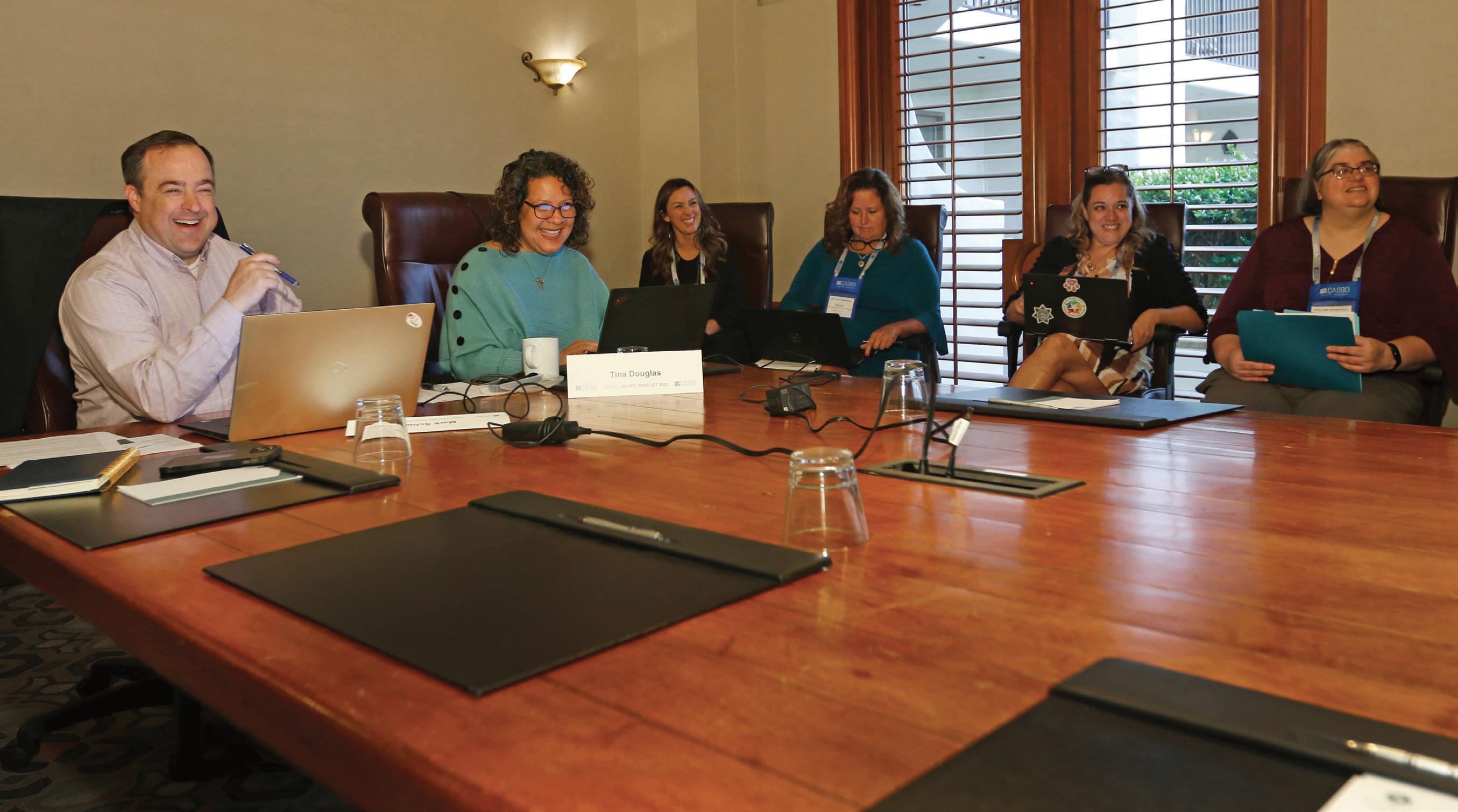
of bargaining. Use the best numbers available.
• Staffing ratios, the number of kids at each grade span, the number of classrooms available and the potential for combination classes.
The district should know where contract language is impacting operation.
6. Be clear about reserves.
Sometimes unions see that a district has reserves and think that means the district has money to offer. If the financial picture improves, districts can spend down some reserves. However, there are many external factors that the reserves may have to cover.
“Maintaining a reserve is very important. The increase in operational costs is going to continue to go up,” says Munoz. “Be very cautious if you use
reserves for salary expenses – that will put a district in dire straits right away. Plus, most district reserves aren’t that high. They can spend those down in just a month of payroll.”
7. Identify non-economic components to work with – for example, teacher prep time.
Many districts are considering whether teacher prep time is cutting into consistent blocks of instructional time. In addition, there’s an associated cost to prep time. In elementary schools, that time is often provided by art or music classes, which require the employment of other certificated employees.
Another example is the language is contracts. Talk to site-level leaders to
understand where cumbersome language makes teacher jobs harder. Looking at average class sizes or maximum class sizes is a good tool. Beware of bargaining with ratios because that can limit employer flexibility on staffing individual schools.
“The district should know where contract language is impacting operation. That information is not from the central office,” says Combs. “We only know this by talking to our site leaders. They are the boots on the ground, doing the work, experiencing any contract impediment.”
8. Trust partners to act in good faith. Once there is a tentative agreement, each side must go to their respective sides and advocate for approval of the terms.
Before the board accepts the proposal, the costs will be disclosed to both the board and the public. Be as accurate and transparent as possible in the disclosure. If you agree to a compensation increase based on monies that are spoken for somewhere else, you’ll get into trouble.
“I’m all for paying employees as much as we can pay them,” says FCMAT’s Fine. “But we have to know we can afford that, or how to make it affordable. It’s a balancing act, no question about it.” z z z
Jennifer Snelling is a freelance writer based in Eugene, Oregon
balancing act, no question about it.




By Jennifer Fink
You can’t predict the future. And yet, you have a responsibility to provide an appropriate education to each student in your district – no matter what disruptions or uncertainties may arise.
That’s where scenario planning comes in.
“In simple terms, scenario planning is a structured way to prepare for multiple plausible futures,” says Yasemin Arikan, director of futures research at NEXT Generation Consulting Inc. “It’s about developing educated insights into how the future may be different from today and then using those insights to inform decisions and actions.”
Scenario planning is distinct from strategic planning and contingency planning. Strategic planning is linear and goal-based; contingency planning focuses on clearly identified, likely-tooccur risks that may interfere with a
district’s strategic plan. In contrast, scenario planning is a dynamic process that considers a broad swath of drivers and outcomes.
Most schools and districts routinely engage in strategic planning and contingency planning; fewer use scenario planning, which is more common in the business world. That’s a mistake in our rapidly changing world.
“In my work, we often encounter planning initiatives that are well-intentioned, but they’re typically based on current or recent budgets – and on the assumption that there’s only one kind of future to prepare for,” Arikan says. “But if an organization always takes that approach – without thinking more broadly or exploring plausible alternative futures through scenario planning – it becomes increasingly risky and less prepared for the future.”
No one knows what, exactly, the future holds for education in California. But one thing is certain: Districts that engage in scenario planning will be better equipped to handle whatever comes along.
Use this six-step approach to prepare for multiple possible futures:
would be prepared for the jobs and careers of the future. So, he reached out to and included business leaders from Boeing, Raytheon, Verizon and Apple.
Diverse stakeholders bring different, essential information to the planning process, facilitating a more robust scenario planning process.
You can start small, if you’d like. If scenario planning is a new concept or practice for your district, begin with simple conversation. Introduce the idea to your cabinet or central office administration; discuss the need to prepare for multiple possibilities. (You can use the COVID-19 pandemic and recent wildfires as vivid examples of disruptive events that required sudden adaptation. Reflect on how prior planning and decisions affected districts’ ability to pivot, with some able to respond more agilely than others.)
Collectively think about where you might focus your efforts. Are there some issues or uncertainties that seem especially relevant to your district now? That may be a great starting point.
Also consider who should be involved. Even if you’re starting small, it’s important to include key stakeholders.
“You can’t scenario plan in isolation,” says Wayne Hickman, Ed.D., assistant professor of educational leadership at Augusta University’s College of Education and Human Development. Diverse stakeholders bring different, essential information to the planning process, facilitating a more robust scenario planning process.
When Darin Brawley, Ed.D., became superintendent of Compton Unified School District in 2012, he was determined to ensure that Compton students
Time to get curious. Put on your metaphorical detective hat and start exploring trends that may impact your school or district. You can begin with historical data, but don’t forget to look more broadly and account for likely variables.
When Andy Paquette, CEO of TMS, a Massachusetts-based consulting firm serving K-12 schools, assists districts with scenario planning, he uses five years of data to conduct a trend analysis of operating expenses and material needs. Then he forecasts three years into the future using both historical and emerging trends, adding in anticipated increases in costs and local tax rates.
Hickman recommends using the PESTLE tool to organize your thinking and identify drivers your team might otherwise neglect. PESTLE Is an acronym that represents six key areas: Political, Economic, Social, Technological, Legal and Environmental. Spend time with your team discussing and identifying issues in each domain that may affect education over the next five years or so. Consider governmental stability and political priorities; economic growth, employment and consumer confidence; local demographics and social priorities; technological innovations and adoption; legal obligations; and climate and environmental influences.
At this stage, “you’re trying to get a 10,000-foot view of the landscape before you start trying to pare that
down into a prioritized, workable set of scenarios that you can then examine,” Hickman says.
Once you’ve identified the possible drivers of change, collectively assess the likelihood and potential impact of each driver. You can use a 2x2 matrix with likelihood on the X-axis (from low to high) and impact on the Y-axis (from low to high) to visually organize your work.
You’ll want to concentrate your efforts on high-likelihood, high-impact drivers; you can ignore low-likelihood, low-impact drivers. (Low-likelihood but high-impact drivers may deserve some attention, but only after your team has developed plans to address the more likely scenarios.) Narrow your focus to the most critical drivers that require immediate and substantial attention.
Use your prioritized drivers to imagine various futures. Think about what might happen in a plausible way, based on those identified forces.
Arikan and other futurists often encourage organizations to ponder at least three distinct possible, plausible futures: An expected future, or one that unfolds in a predictable way according to current trends; a challenging future , in which multiple disruptions happen simultaneously or key supports decline precipitously or disappear; and a surprisingly successful future that may result if the right things happen in the right ways. Together, discuss how each scenario could practically impact your district’s finances, staffing, programming and students. What challenges might arise? What opportunities?
Put on your metaphorical detective hat and start exploring trends that may impact your school or district.

An example: Although the president of the United States has directed the Secretary of Education to take all necessary steps to facilitate the closure of the Department of Education (DOE), no one yet knows when or how that may happen. Scenario planning helps districts explore possibilities. In an expected scenario, funding and support from the DOE continue as it has in the past. In a plausible challenging future , changes at the federal level result in decreased funding to the state, while the population of students requiring special education services continues to grow. In a surprisingly successful future, support from the state and local municipalities, as well as partnerships with businesses and nonprofit organizations, allow districts to continue to meet
the needs of students who require special education services, even though federal support declines.
Collectively or in separate working groups, consider how your school or district could fulfill its mission in each plausible scenario.
“The question you’re trying to answer is: What do we want to happen and what will it take to get us there?” Arikan says. Think about things you can control or influence, particularly things that may help you in multiple futures. Strong relationships with district families and local businesses, for instance,


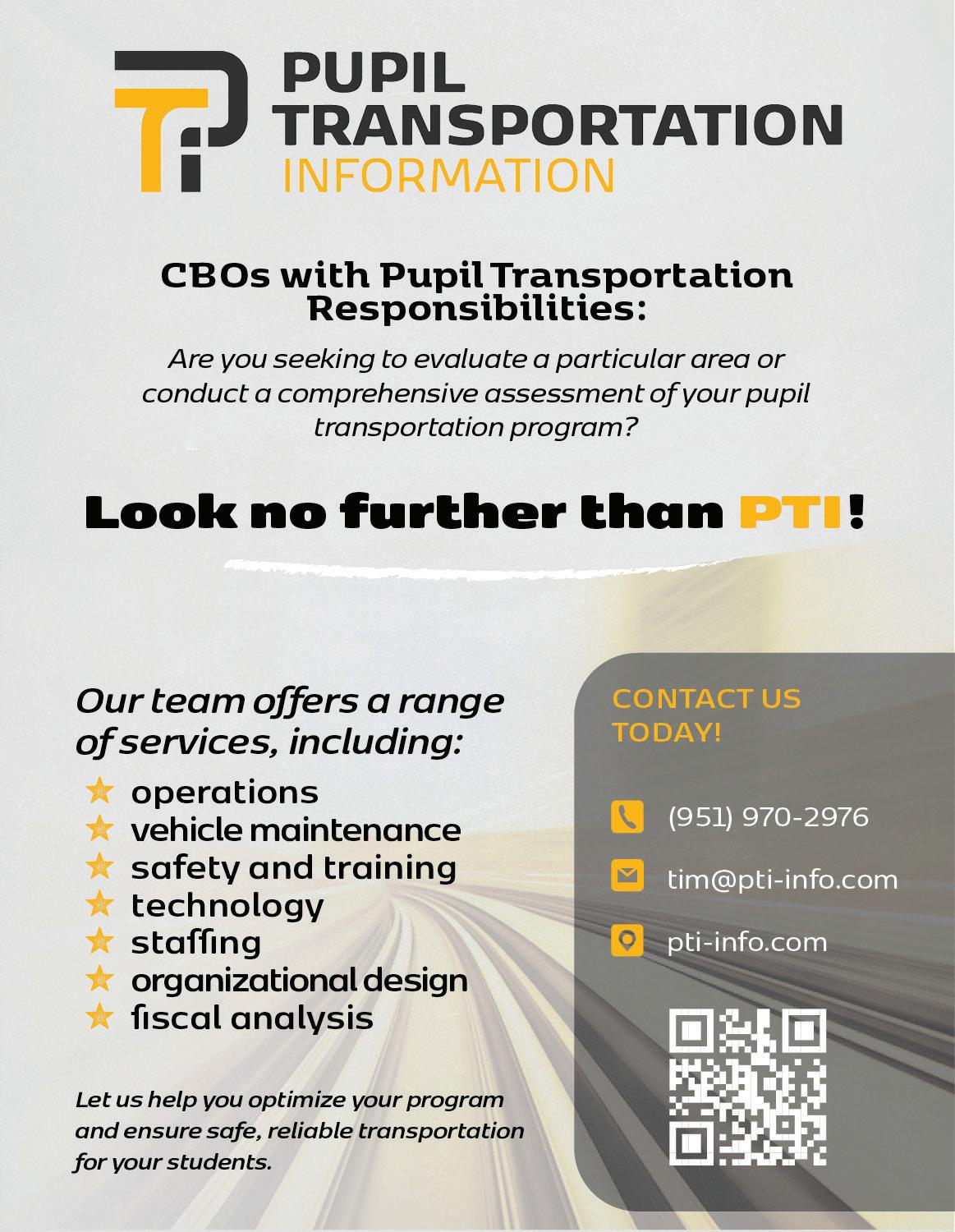

CASBO Volunteer Hub is your gateway to serving the school business industry and shaping a better future for TK-14 education in California.
Search 1,000+ positions that fit your skills, schedule and interests.
Scan the QR code to update your profile and get started today! Or visit volunteer.casbo.org and login using your CASBO credentials.

will be an asset in every possible version of the future, so it makes sense to devote time and resources toward relationship building.
school nurse – to assess current funding streams and explore alternative ways to meet student needs in the least restrictive environment.
Scenario planning doesn’t eliminate uncertainty; it helps you manage it.
Drill down to identify your musthaves and must-dos. “We’re always analyzing and thinking about the core things we need to provide versus things that are nice to have and things that can go away if they have to,” says Brawley, Compton Unified’s superintendent. “We use a green/yellow/red system – yellow is stuff that we’ll try to keep in place; red can go away immediately, if needed; and green continues.” Categorizing programs, services and even equipment in that manner gives Compton Unified the ability to pivot quickly when needed.
Now is the time to craft contingency plans, so involve key stakeholders as needed. Given current uncertainty, most districts may want to take a close look at how to continue funding the supports required by students with IEPs and 504 plans. That means bringing your special education director and finance director into the conversation – along with others, like your transportation lead or

Transparently share scenarios and plans with all stakeholders. Sharing the reality of your situation – for instance, the total cost of district operations and various funding streams, as well as likely impacts and possible adaptations – fosters trust. When your community understands the challenges you face and the efforts exerted so you’re ready to adapt as needed, it’s more inclined to work with you, rather than push back, when tough decisions must be made.
“Your community may say, look, we want to keep our tax rate down for the citizenry. But should scenarios C or D occur, come back to us and we’ll start with a supplemental appropriation,” Paquette says.
Scenario planning doesn’t eliminate uncertainty; it helps you manage it. By exploring a range of plausible futures and involving diverse perspectives, school leaders can build flexibility and resilience for tomorrow. z z z
Jennifer Fink is a freelance writer based in Mayville, Wisconsin.
Is your district using scenario planning or a similar planning framework to prepare for the future? Email us at insight @ casbo.org.
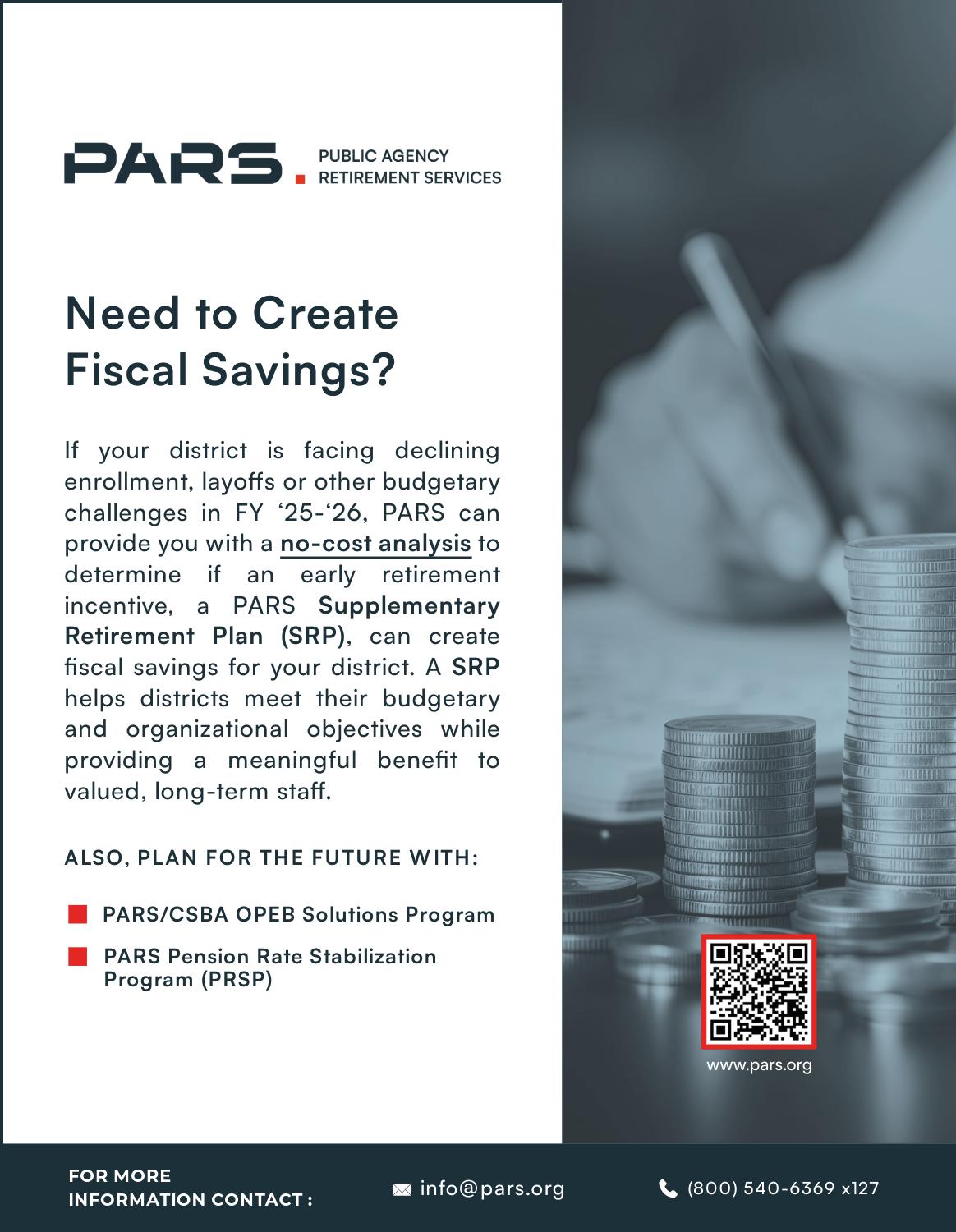




Over 475 California public school districts have joined together to make SISC what it is today.
We have a 45 year history of providing our members with coverage for workers’ compensation, property and liability and health benefits. Districts join SISC for our consistently low rates, but the reason they stay for decades is because of our people and the great service they provide.
We’d love to serve you, too.






Stifel is the leading underwriter of California K-12 school district bonds.* We assist local districts in providing financing for facility projects and cash flow borrowing, including new construction, modernization, renovation, and technology improvements. Our work with California school districts includes:
■ General Obligation Bonds
■ Mello-Roos Bonds
■ Certificates of Participation/Leases
■ Short-Term Notes and TRANs
■ Refinancing or Restructuring of Previously Issued Bonds
We give back to the communities we serve by providing college scholarships to graduating high school seniors through Stifel’s annual Fabric of Society essay competition and by supporting school-related foundations and functions with charitable contributions.
* Source: LSEG, negotiated transactions ranked by number of issues for 2024 as of January 7, 2025 Stifel, Nicolaus & Company, Incorporated
364-6839 bkerns@stifel.com
364-6841 egonzalez@stifel.com
364-6879 bartolottae@stifel.com
443-5006 dvincent@stifel.com
(213) 443-5205 rbarna@stifel.com
443-5077 vegaf@stifel.com